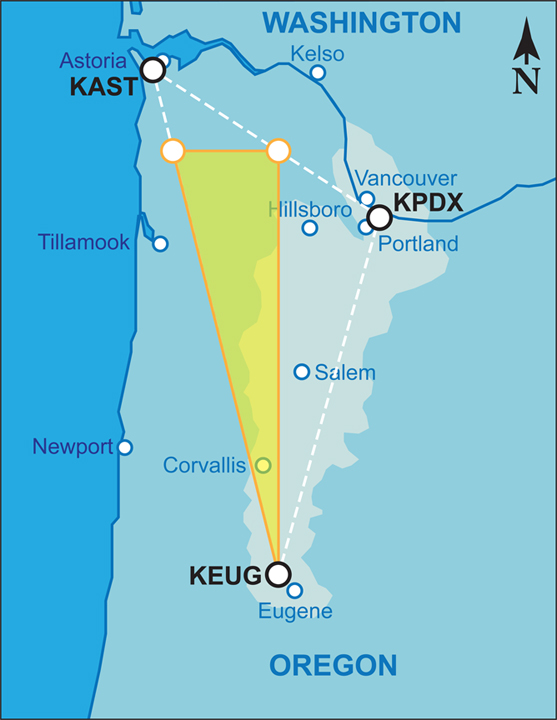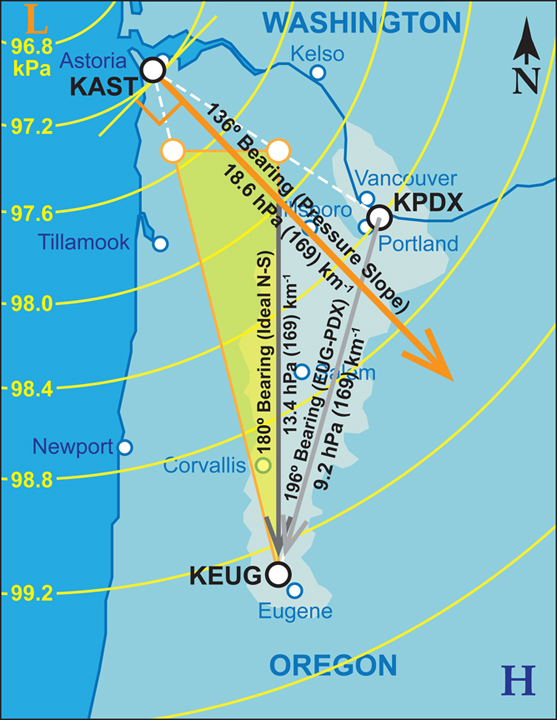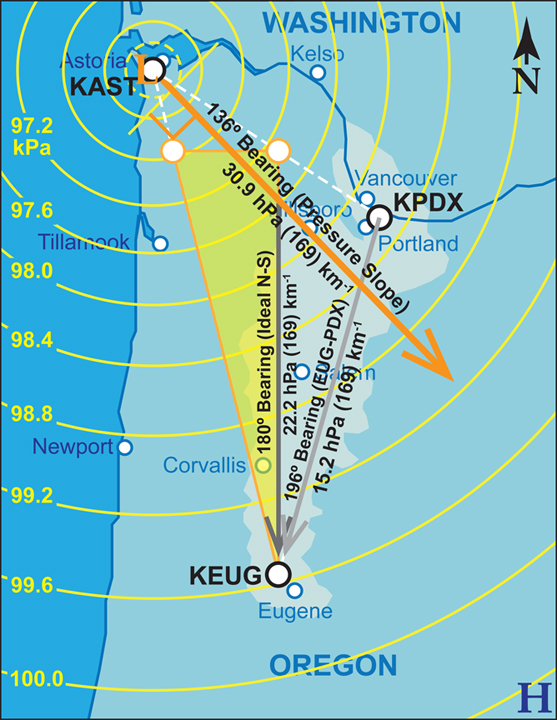When considering the pressure gradient outcomes of different storm tracks, the EUG-PDX measure is not favored for high readings for paths that are northeast to north and especially offshore. A low tracking east to northeast that moves inland just to the north of the Willamette Valley is better positioned to produce a higher EUG-PDX pressure gradient due to a tendency for isobars to be arranged nearly perpendicular to a line drawn between EUG and PDX, an ideal alignment for high EUG-PDX gradient readings and also a good arrangement for ageostrophic southerly winds. Indeed, the bearing from PDX to EUG is 196° so even a nice south-to-north arrangement of isobars--a southerly pressure slope (see Lange 1998 for discussion of pressure slopes)--is not exactly an ideal setup for maximizing the EUG-PDX pressure gradient measure. Any deviation from a 196° azimuth reduces the EUG-PDX magnitude. In other words, gradients determined by using two fixed stations are likely to be under-reported. This happened quite strongly during the CDS. EUG-PDX is a two-point or one-dimensional (1D) estimation of the pressure gradient. Two-point systems are limited by the fact that most of the time the pressure slope does not exactly match the bearing between weather stations. If three stations are used then the pressure-gradient orientation can be approximately determined, and the gradient calculated on a line that is perpendicular to the isobaric arrangement. The pressure gradient value is accompanied by a measure of the pressure slope (some might prefer to call this pressure aspect or azimuth) in degrees. The pressure slope can be considered the ageostrophic wind direction determined by the calculated isobaric arrangement. The key advantage to the three-point system is that it closely captures the pressure gradient value for the region enclosed by the triad of stations, regardless of how the isobars are oriented. The magnitude of the gradient can be estimated over any distance inside the area delineated by the three stations, and even estimated outside of the boundaries though error would be higher. Using Astoria (AST), EUG and PDX sea-level pressure observations, 2D pressure gradients were constructed by employing what is sometimes called a pressure-wind triangle (Figure 2.1). Pressure-wind triangles can be used to estimate the geostrophic potential wind within the polygon, and from that surface winds can be estimated. The method used for the calculation of the geostrophic potential wind magnitude is from Stull (2015). A right triangle is required, and in the case of the arrangement of the three stations used here, this necessitates the use of two interpolation points. Linear estimation is used, which is a source of error because pressure gradients are not always even across large distances. Other stations in an arrangement closer to a right triangle could have been selected. However, AST, EUG and PDX were chosen due to their long period of largely uninterrupted record of barometric pressure, allowing many storms from history to be analyzed. Since pressure-wind triangles closely capture the actual gradient for a given time, the calculated values are here referred to as the absolute pressure gradient, to distinguish them from 1D measures. Absolute pressure gradients are typically reported over a distance of 100 km (e.g. 5.0 hPa/100 km). |

Figure 2.1 above Schematic of a pressure-wind triangle using the stations KEUG, KPDX and KAST (black circles). Two pressure interpolation points are shown (orange circles). The right triangle used for pressure gradient and geostrophic wind calculations is highlighted (orange outline with yellow shading). The Willamette Valley and adjacent lowlands in Washington are roughly outlined with lighter shading. |
Hourly gradients were calculated for the CDS. The maximum gradient inside this triangle, 11.0 hPa/100 km (i.e. 11.0 mb over 100 km) occurred at 03:00 UTC on 13 Oct 1962 (Figure 2.2). This is noticeably above the +9.6 hPa determined from the 2-point EUG-PDX system, and over a smaller distance. For easier comparisons, a scale of 169 km (105 miles), the distance between EUG and PDX, is used in place of 100 km. This results in an intense peak gradient of 18.6 hPa/169 km. To show how dramatically the 2-point system failed to capture the actual pressure gradient during the CDS, the magnitude of gradient can be calculated along a bearing of 196° within the triangle for 03:00 UTC (Figure 2.2). In so doing, the number is reduced to 9.2 hPa/169 km, close to the raw measured peak 1D gradient value and just half of the real magnitude. The peak EUG-PDX gradient occurred one hour ahead of the peak EUG-PDX-AST gradient. At 02:00 UTC 13 Oct 1962, the absolute gradient had reached 17.4 hPa/169 km and, due to a more favorable pressure slope (e.g. the isobars were more nearly perpendicular to the 196° bearing than during 03:00 UTC) the estimated EUG-PDX gradient reached its peak of 9.5 hPa/169 km, just 0.1 hPa off of the raw value calculated directly from the 2-point system. This suggests that the 3-point model is working rather well. |

Figure 2.2 above The time of maximum pressure gradient for the Willamette Valley during the CDS, 03:00 UTC 13 Oct 1962. The orientation and magnitude of the pressure slope is shown (orange arrow). The 1D EUG-PDX measure is also indicated (lighter gray arrow) alongside the pressure gradient along a perfect N-S axis (dark gray arrow). The indicated isobars (yellow lines) are idealized. The location of highs (H) and lows (L) are for reference and may not indicate the exact centers of circulation. |
The gradient for any bearing can be estimated within the triangle. The exact orientation of the geography defining the Willamette Valley can be quibbled over and appears to depend on the latitudinal position within the Valley, but an 180° bearing, instead of the 196° between EUG and PDX, might be considered a more ideal orientation for gauging storms that produce strong southerly winds. Therefore, for the Willamette Valley, the pressure gradient value along 180° could be considered the effective gradient for a given storm. For the 180° bearing during the CDS, the peak gradient occurred at 03:00 UTC with a value of 13.4 hPa/169 km (Figure 2.2). Peak gradients were also calculated using the 3-point system for 27 significant windstorms that occurred from 1945-2012, with the majority of events between 1957 and 2000. Pressure data from either AST or EUG are missing from several key storms in the early-to-mid 1950s, and are increasingly spotty for all the stations earlier than about 1950. Storms analyzed with the 3-point system include many of the “classic” windstorms that followed north to north-northeast paths offshore in a manner similar to the CDS: 04 Dec 1945, 14 Apr 1957, 26 Mar 1971, 14 Nov 1981, 12 Dec 1995 and 16 Jan 2000. The peak absolute gradient for the CDS of 18.6 hPa/169 km and the maximum effective (along the 180° bearing) gradient of 13.4 hPa/169 km are the highest among all 27 storms (Table 2.1). This is a particularly interesting result given that land-falling systems that track north of the Willamette Valley are best situated for the highest pressure gradient readings, especially along a 180° orientation, due to close passage of the low-pressure center and an expected favorable southerly pressure slope. |
Event |
Peak |
Peak |
Time of Peak Gradient |
Peak Gradient for 180° Orientation |
12 Oct 1962 |
18.6 |
136 |
03:00 13 Oct |
13.4 |
|
|
|
|
|
08 Jan 1990 |
16.9 |
238 |
10:00 08 Jan |
13.1 |
02 Oct 1967 |
16.2 |
228 |
05:00 02 Oct |
10.8 |
24 Nov 1983 |
15.2 |
144 |
16:00 24 Nov |
12.4 |
12 Dec 1995 |
15.0 |
144 |
00:00 13 Dec |
12.0 |
14 Nov 1981 |
15.0 |
139 |
14:00 14 Nov |
11.6 |
Table 2.1 above Windstorms with the top five peak pressure gradients after the 12 Oct 1962 CDS. Shown is the maximum pressure gradient in hPa/169 km along the pressure slope (bearing in degrees), the time of occurrence and the gradient magnitdue adjusted along a bearing of 180°. |
The next two strongest events behind the CDS, 08 Jan 1990 and 02 Oct 1967, were land-falling storms that tracked just north of Portland, offering nearly ideal setups for strong pressure gradient readings. However, the peak gradient of both storms occurred during a phase with a southwest (~225°) pressure slope, which mitigated some of the effectiveness for southerly winds as indicated by markedly lower gradients along a 180° bearing, especially for the 1967 event. The 24 Nov 1983 windstorm tracked north-northeast across the Olympic Peninsula, not quite a classic path but nevertheless rather close. Given the magnitude of pressure gradient for the 1983 Thanksgiving Day storm, and its timing on a holiday, it is a wonder that this event is not discussed more. It appears to be one of the forgotten big windstorms of history. The final two storms on the list, 14 Nov 1981 and 12 Dec 1995, were both major classic events that followed a track similarly, but not exactly, to the CDS. The 12 Dec 1995 event tracked across the tip of the Olympic Peninsula just west of the 1983 storm. Interestingly, all three events, 1981, 1983 and 1995, produced southeast (~135°) pressure slopes at the time of peak gradient, much like to the CDS. This is the mark of lows tracking offshore at closest approach to the pressure-wind triangle, as opposed to lows tracking inland at closest approach. The tendency for peak gradient with a southeast pressure slope likely mitigates the magnitude of these storms, as indicated by lower gradient values along the 180° bearing. If the Willamette Valley were oriented more like the Georgia Strait (northeast-southeast instead of north-south), then one might expect classic windstorms to have an even more dramatic impact than they already do. The northward movement of these storms, which can add a significant vector component depending on storm speed, and also implying the potential for a favorable upper-wind direction for the support of southerly winds, likely offsets some of the unfavorable gradient orientation. |

